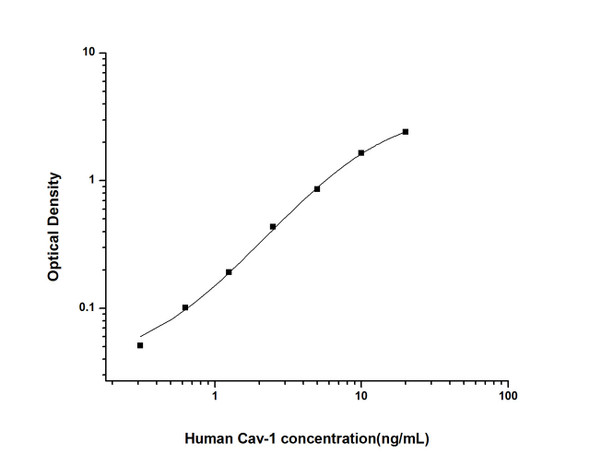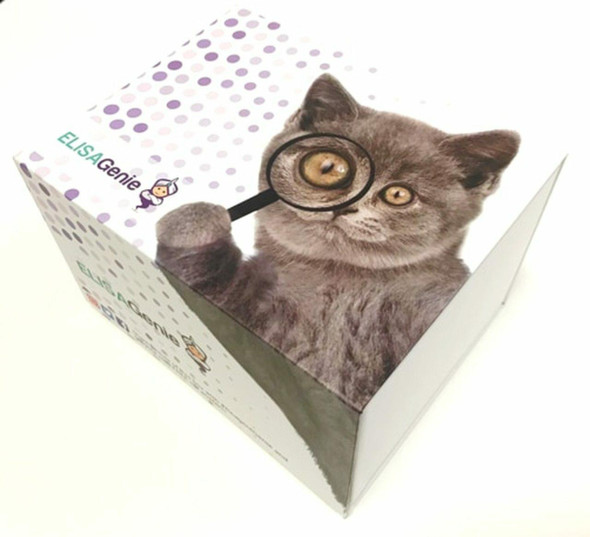Human Immunology ELISA Kits 1
Human Cav-1 (Caveolin-1) CLIA Kit (HUES00443)
- SKU:
- HUES00443
- Product Type:
- ELISA Kit
- ELISA Type:
- CLIA Kit
- Size:
- 96 Assays
- Sensitivity:
- 37.5pg/mL
- Range:
- 62.5-4000pg/mL
- ELISA Type:
- Sandwich
- Reactivity:
- Human
- Sample Type:
- Serum, plasma and other biological fluids
- Research Area:
- Immunology
Description
| Assay type: | Sandwich |
| Format: | 96T |
| Assay time: | 4.5h |
| Reactivity: | Human |
| Detection method: | Chemiluminescence |
| Detection range: | 62.50-4000 pg/mL |
| Sensitivity: | 37.50 pg/mL |
| Sample volume: | 100µL |
| Sample type: | Serum, plasma and other biological fluids |
| Repeatability: | CV < 15% |
| Specificity: | This kit recognizes Human Cav-1 in samples. No significant cross-reactivity or interference between Human Cav-1 and analogues was observed. |
This kit uses Sandwich-CLIA as the method. The micro CLIA plate provided in this kit has been pre-coated with an antibody specific to Human Cav-1. Standards or samples are added to the appropriate micro CLIA plate wells and combined with the specific antibody. Then a biotinylated detection antibody specific for Human Cav-1 and Avidin-Horseradish Peroxidase (HRP) conjugate are added to each micro plate well successively and incubated. Free components are washed away. The substrate solution is added to each well. Only those wells that contain Human Cav-1, biotinylated detection antibody and Avidin-HRP conjugate will appear fluorescence. The Relative light unit (RLU) value is measured spectrophotometrically by the Chemiluminescence immunoassay analyzer. The RLU value is positively associated with the concentration of Human Cav-1. The concentration of Human Cav-1 in the samples can be calculated by comparing the RLU of the samples to the standard curve.
| UniProt Protein Function: | Caveolin-1: May act as a scaffolding protein within caveolar membranes. Interacts directly with G-protein alpha subunits and can functionally regulate their activity. Involved in the costimulatory signal essential for T-cell receptor (TCR)- mediated T-cell activation. Its binding to DPP4 induces T-cell proliferation and NF-kappa-B activation in a T-cell receptor/CD3- dependent manner. Recruits CTNNB1 to caveolar membranes and may regulate CTNNB1-mediated signaling through the Wnt pathway. Homooligomer. Interacts with GLIPR2, NOSTRIN, SNAP25 and syntaxin. Interacts with rotavirus A NSP4. Interacts (via the N- terminus) with DPP4; the interaction is direct. Interacts with CTNNB1, CDH1 and JUP. Interacts with BMX and BTK. Expressed in muscle and lung, less so in liver, brain and kidney. Belongs to the caveolin family. 2 isoforms of the human protein are produced by alternative initiation. |
| UniProt Protein Details: | Protein type:Motility/polarity/chemotaxis; Adaptor/scaffold; Nuclear receptor co-regulator Chromosomal Location of Human Ortholog: 7q31. 1 Cellular Component: protein complex; focal adhesion; integral to plasma membrane; basolateral plasma membrane; endoplasmic reticulum; lipid particle; cell cortex; caveola; acrosomal membrane; cilium; lipid raft; Golgi membrane; early endosome membrane; perinuclear region of cytoplasm; apical plasma membrane; plasma membrane; intracellular; cytoplasmic vesicle; endosome Molecular Function:identical protein binding; protein binding; protease activator activity; enzyme binding; cholesterol binding; patched binding; protein complex scaffold; structural molecule activity; nitric-oxide synthase binding; protein kinase binding; receptor binding Biological Process: mammary gland involution; viral reproduction; negative regulation of epithelial cell differentiation; negative regulation of tyrosine phosphorylation of Stat5 protein; nitric oxide homeostasis; negative regulation of BMP signaling pathway; calcium ion homeostasis; protein localization; sequestering of lipid; regulation of the force of heart contraction by chemical signal; regulation of fatty acid metabolic process; negative regulation of protein binding; inactivation of MAPK activity; regulation of smooth muscle contraction; maintenance of cellular protein localization; skeletal muscle development; cytosolic calcium ion homeostasis; negative regulation of nitric-oxide synthase activity; cellular response to starvation; membrane depolarization; cholesterol homeostasis; response to estrogen stimulus; T cell costimulation; negative regulation of endothelial cell proliferation; negative regulation of protein ubiquitination; regulation of nitric-oxide synthase activity; response to calcium ion; response to progesterone stimulus; negative regulation of JAK-STAT cascade; leukocyte migration; lactation; vesicle organization and biogenesis; negative regulation of peptidyl-serine phosphorylation; negative regulation of pinocytosis; negative regulation of transcription from RNA polymerase II promoter; nitric oxide metabolic process; mammary gland development; calcium ion transport; negative regulation of cytokine and chemokine mediated signaling pathway; angiogenesis; vasculogenesis; protein homooligomerization; vasoconstriction; cholesterol transport; negative regulation of MAPKKK cascade; negative regulation of nitric oxide biosynthetic process; MAPKKK cascade; positive regulation of metalloenzyme activity; positive regulation of peptidyl-serine phosphorylation; regulation of peptidase activity; cellular calcium ion homeostasis; triacylglycerol metabolic process; regulation of blood coagulation; response to hypoxia; positive regulation of vasoconstriction; blood coagulation; vascular endothelial growth factor receptor signaling pathway Disease: Lipodystrophy, Congenital Generalized, Type 3; Partial Lipodystrophy, Congenital Cataracts, And Neurodegeneration Syndrome; Pulmonary Hypertension, Primary, 3 |
| NCBI Summary: | The scaffolding protein encoded by this gene is the main component of the caveolae plasma membranes found in most cell types. The protein links integrin subunits to the tyrosine kinase FYN, an initiating step in coupling integrins to the Ras-ERK pathway and promoting cell cycle progression. The gene is a tumor suppressor gene candidate and a negative regulator of the Ras-p42/44 mitogen-activated kinase cascade. Caveolin 1 and caveolin 2 are located next to each other on chromosome 7 and express colocalizing proteins that form a stable hetero-oligomeric complex. Mutations in this gene have been associated with Berardinelli-Seip congenital lipodystrophy. Alternatively spliced transcripts encode alpha and beta isoforms of caveolin 1. [provided by RefSeq, Mar 2010] |
| UniProt Code: | Q03135 |
| NCBI GenInfo Identifier: | 13637934 |
| NCBI Gene ID: | 857 |
| NCBI Accession: | Q03135. 4 |
| UniProt Secondary Accession: | Q03135,Q9UGP1, Q9UNG1, Q9UQH6, |
| UniProt Related Accession: | Q03135 |
| Molecular Weight: | 178 |
| NCBI Full Name: | Caveolin-1 |
| NCBI Synonym Full Names: | caveolin 1, caveolae protein, 22kDa |
| NCBI Official Symbol: | CAV1 |
| NCBI Official Synonym Symbols: | CGL3; PPH3; BSCL3; LCCNS; VIP21; MSTP085 |
| NCBI Protein Information: | caveolin-1; cell growth-inhibiting protein 32 |
| UniProt Protein Name: | Caveolin-1 |
| Protein Family: | Caveolin |
| UniProt Gene Name: | CAV1 |
| UniProt Entry Name: | CAV1_HUMAN |
As the RLU values of the standard curve may vary according to the conditions of the actual assay performance (e. g. operator, pipetting technique, washing technique or temperature effects), the operator should establish a standard curve for each test. Typical standard curve and data is provided below for reference only.
| Concentration (pg/mL) | RLU | Average | Corrected |
| 4000 | 56068 62094 | 59081 | 59046 |
| 2000 | 27316 28402 | 27859 | 27824 |
| 1000 | 13958 13010 | 13484 | 13449 |
| 500 | 6588 6622 | 6605 | 6570 |
| 250 | 3320 3166 | 3243 | 3208 |
| 125 | 1704 1458 | 1581 | 1546 |
| 62.50 | 731 779 | 755 | 720 |
| 0 | 34 36 | 35 | -- |
Precision
Intra-assay Precision (Precision within an assay): 3 samples with low, mid range and high level Human Cav-1 were tested 20 times on one plate, respectively.
Inter-assay Precision (Precision between assays): 3 samples with low, mid range and high level Human Cav-1 were tested on 3 different plates, 20 replicates in each plate.
| Intra-assay Precision | Inter-assay Precision | |||||
| Sample | 1 | 2 | 3 | 1 | 2 | 3 |
| n | 20 | 20 | 20 | 20 | 20 | 20 |
| Mean (pg/mL) | 187.90 | 489.06 | 1495.25 | 175.33 | 534.89 | 1462.98 |
| Standard deviation | 15.60 | 49.64 | 153.86 | 21.21 | 53.76 | 143.96 |
| C V (%) | 8.30 | 10.15 | 10.29 | 12.10 | 10.05 | 9.84 |
Recovery
The recovery of Human Cav-1 spiked at three different levels in samples throughout the range of the assay was evaluated in various matrices.
| Sample Type | Range (%) | Average Recovery (%) |
| Serum (n=5) | 89-102 | 96 |
| EDTA plasma (n=5) | 86-100 | 93 |
| Cell culture media (n=5) | 85-99 | 91 |
Linearity
Samples were spiked with high concentrations of Human Cav-1 and diluted with Reference Standard & Sample Diluent to produce samples with values within the range of the assay.
| Serum (n=5) | EDTA plasma (n=5) | Cell culture media (n=5) | ||
| 1:2 | Range (%) | 87-99 | 83-96 | 84-97 |
| Average (%) | 94 | 90 | 91 | |
| 1:4 | Range (%) | 88-100 | 86-101 | 85-98 |
| Average (%) | 94 | 93 | 92 | |
| 1:8 | Range (%) | 84-99 | 91-104 | 90-104 |
| Average (%) | 91 | 97 | 96 | |
| 1:16 | Range (%) | 89-101 | 93-107 | 86-101 |
| Average (%) | 95 | 99 | 92 |
An unopened kit can be stored at 4°C for 1 month. If the kit is not used within 1 month, store the items separately according to the following conditions once the kit is received.
| Item | Specifications | Storage |
| Micro CLIA Plate(Dismountable) | 8 wells ×12 strips | -20°C, 6 months |
| Reference Standard | 2 vials | |
| Concentrated Biotinylated Detection Ab (100×) | 1 vial, 120 µL | |
| Concentrated HRP Conjugate (100×) | 1 vial, 120 µL | -20°C(shading light), 6 months |
| Reference Standard & Sample Diluent | 1 vial, 20 mL | 4°C, 6 months |
| Biotinylated Detection Ab Diluent | 1 vial, 14 mL | |
| HRP Conjugate Diluent | 1 vial, 14 mL | |
| Concentrated Wash Buffer (25×) | 1 vial, 30 mL | |
| Substrate Reagent A | 1 vial, 5 mL | 4°C (shading light) |
| Substrate Reagent B | 1 vial, 5 mL | 4°C (shading light) |
| Plate Sealer | 5 pieces | |
| Product Description | 1 copy | |
| Certificate of Analysis | 1 copy |
- Set standard, test sample and control (zero) wells on the pre-coated plate and record theirpositions. It is recommended to measure each standard and sample in duplicate. Note: addall solutions to the bottom of the plate wells while avoiding contact with the well walls. Ensuresolutions do not foam when adding to the wells.
- Aliquot 100µl of standard solutions into the standard wells.
- Add 100µl of Sample / Standard dilution buffer into the control (zero) well.
- Add 100µl of properly diluted sample (serum, plasma, tissue homogenates and otherbiological fluids. ) into test sample wells.
- Cover the plate with the sealer provided in the kit and incubate for 90 min at 37°C.
- Aspirate the liquid from each well, do not wash. Immediately add 100µL of BiotinylatedDetection Ab working solution to each well. Cover the plate with a plate seal and gently mix. Incubate for 1 hour at 37°C.
- Aspirate or decant the solution from the plate and add 350µL of wash buffer to each welland incubate for 1-2 minutes at room temperature. Aspirate the solution from each well andclap the plate on absorbent filter paper to dry. Repeat this process 3 times. Note: a microplatewasher can be used in this step and other wash steps.
- Add 100µL of HRP Conjugate working solution to each well. Cover with a plate seal andincubate for 30 min at 37°C.
- Aspirate or decant the solution from each well. Repeat the wash process for five times asconducted in step 7.
- Add 100µL of Substrate mixture solution to each well. Cover with a new plate seal andincubate for no more than 5 min at 37°C. Protect the plate from light.
- Determine the RLU value of each well immediately.






